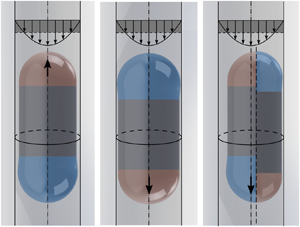Article contents
Non-unique bubble dynamics in a vertical capillary with an external flow
Published online by Cambridge University Press: 01 February 2021
Abstract

We study bubble motion in a vertical capillary tube under an external flow. Bretherton (J. Fluid Mech., vol. 10, issue 2, 1961, pp. 166–188) has shown that, without external flow, a bubble can spontaneously rise when the Bond number ( ${Bo} \equiv \rho g R^2 / \gamma$) is above the critical value
${Bo} \equiv \rho g R^2 / \gamma$) is above the critical value  ${Bo}_{cr}=0.842$, where
${Bo}_{cr}=0.842$, where  $\rho$ is the liquid density,
$\rho$ is the liquid density,  $g$ the gravitational acceleration,
$g$ the gravitational acceleration,  $R$ the tube radius and
$R$ the tube radius and  $\gamma$ the surface tension. It was then shown by Magnini et al. (Phys. Rev. Fluids, vol. 4, issue 2, 2019, 023601) that the presence of an imposed liquid flow, in the same (upward) direction as buoyancy, accelerates the bubble and thickens the liquid film around it. In this work we carry out a systematic study of the bubble motion under a wide range of upward and downward external flows, focusing on the inertialess regime with Bond numbers above the critical value. We show that a rich variety of bubble dynamics occurs when an external downward flow is applied, opposing the buoyancy-driven rise of the bubble. We reveal the existence of a critical capillary number of the external downward flow (
$\gamma$ the surface tension. It was then shown by Magnini et al. (Phys. Rev. Fluids, vol. 4, issue 2, 2019, 023601) that the presence of an imposed liquid flow, in the same (upward) direction as buoyancy, accelerates the bubble and thickens the liquid film around it. In this work we carry out a systematic study of the bubble motion under a wide range of upward and downward external flows, focusing on the inertialess regime with Bond numbers above the critical value. We show that a rich variety of bubble dynamics occurs when an external downward flow is applied, opposing the buoyancy-driven rise of the bubble. We reveal the existence of a critical capillary number of the external downward flow ( ${Ca}_l \equiv \mu U_l/\gamma$, where
${Ca}_l \equiv \mu U_l/\gamma$, where  $\mu$ is the fluid viscosity and
$\mu$ is the fluid viscosity and  $U_l$ is the mean liquid speed) at which the bubble arrests and changes its translational direction. Depending on the relative direction of gravity and the external flow, the thickness of the film separating the bubble surface and the tube inner wall follows two distinct solution branches. The results from theory, experiments and numerical simulations confirm the existence of the two solution branches and reveal that the two branches overlap over a finite range of
$U_l$ is the mean liquid speed) at which the bubble arrests and changes its translational direction. Depending on the relative direction of gravity and the external flow, the thickness of the film separating the bubble surface and the tube inner wall follows two distinct solution branches. The results from theory, experiments and numerical simulations confirm the existence of the two solution branches and reveal that the two branches overlap over a finite range of  ${Ca}_l$, thus suggesting non-unique, history-dependent solutions for the steady-state film thickness under the same external flow conditions. Furthermore, inertialess symmetry-breaking shape profiles at steady state are found as the bubble transits near the tipping points of the solution branches, which are shown in both experiments and three-dimensional numerical simulations.
${Ca}_l$, thus suggesting non-unique, history-dependent solutions for the steady-state film thickness under the same external flow conditions. Furthermore, inertialess symmetry-breaking shape profiles at steady state are found as the bubble transits near the tipping points of the solution branches, which are shown in both experiments and three-dimensional numerical simulations.
JFM classification
Information
- Type
- JFM Papers
- Information
- Copyright
- © The Author(s), 2021. Published by Cambridge University Press
References
REFERENCES
- 7
- Cited by


